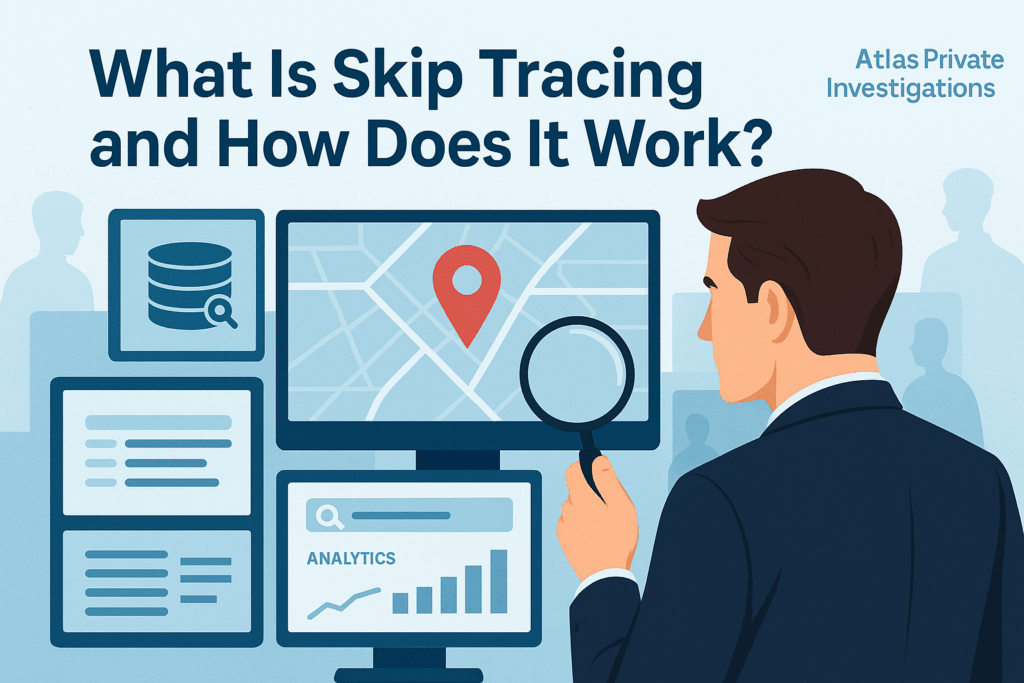In today’s digital age, tracking down people who have disappeared, defaulted on payments, or gone off the radar is more complex than ever. This is where skip tracing becomes an essential investigative process. Whether it’s for legal cases, debt recovery, or locating missing individuals, skip tracing combines data, analytics, and investigative expertise to find people effectively and ethically. What Is Skip Tracing and How Does It Work.

This article will explain what skip tracing is, how it works, and why professional skip tracers play a crucial role in delivering reliable results.
Understanding Skip Tracing
Skip tracing is the process of locating a person’s whereabouts when their contact information or address is no longer valid. The word “skip” refers to someone who has “skipped town” or moved away, while “tracing” means following the trail of information they’ve left behind.
Skip tracing is widely used in industries such as:
-
Private investigations
-
Debt collection and recovery
-
Law enforcement and legal services
-
Insurance and fraud prevention
-
Real estate and tenant screening
Essentially, skip tracing helps professionals reconnect with people who are intentionally or unintentionally hard to find. What Is Skip Tracing and How Does It Work.
How Skip Tracing Works: Step-by-Step Process
Skip tracing involves multiple layers of research, verification, and cross-referencing. Here’s a breakdown of how professionals conduct skip tracing:
1. Collecting Initial Data
The first step is to gather all available information about the person of interest. This includes:
-
Full name and known aliases
-
Date of birth and last known address
-
Employment history
-
Contact numbers and email addresses
-
Relatives, friends, or associates
-
Public records and online profiles
The goal is to build a preliminary profile that guides further investigation.
2. Accessing Databases and Public Records
Professional skip tracers use specialized databases and public record systems to verify and expand on the information they have. Sources may include:
-
Property and utility records
-
Voter registrations
-
Credit reports
-
Vehicle registrations
-
Business ownership filings
-
Court and legal documents
Unlike casual internet searches, these databases provide accurate, legally obtained information that helps pinpoint leads. What Is Skip Tracing and How Does It Work.
3. Analyzing Digital Footprints
In today’s connected world, nearly everyone leaves traces online. Skilled skip tracers use digital footprint analysis to find clues on:
-
Social media activity
-
Online purchases and interactions
-
Professional networking platforms
-
Location tags and digital check-ins
This data helps identify potential locations, travel patterns, or current connections. What Is Skip Tracing and How Does It Work.
4. Contacting Known Associates
When database research is inconclusive, skip tracers reach out to family members, friends, former employers, or neighbors — always within legal and ethical limits. These conversations can uncover valuable information about the person’s recent activities or whereabouts.
5. Verification and Reporting
Once potential leads are identified, each piece of information is carefully verified. False data is filtered out, and only confirmed details are included in the final report provided to clients.
Professional skip tracers ensure that all findings are accurate, lawful, and well-documented for legal or investigative use.
The Role of Professional Skip Tracers
While anyone can try basic online searches, professional skip tracers possess the tools, licenses, and expertise required to conduct thorough, compliant investigations. They understand privacy laws, ethical boundaries, and proper documentation procedures.
Benefits of Hiring a Professional Skip Tracer:
-
Access to exclusive investigative databases
-
Legal compliance and data protection
-
Expertise in verifying complex information
-
Confidential and discreet service
-
Faster, more reliable results
Hiring a licensed investigator ensures that every part of the process meets Canadian legal and ethical standards, especially under privacy and data protection laws.
Is Skip Tracing Legal in Canada?
Yes, skip tracing is legal in Canada, provided it’s conducted ethically and within the framework of federal and provincial privacy laws. Professional investigators must use lawful information sources and respect individuals’ rights to privacy.
Unethical practices like impersonation, data theft, or harassment are strictly prohibited. Always ensure you work with a licensed private investigation agency to maintain compliance.
Common Situations Where Skip Tracing Is Used
Skip tracing can assist in many scenarios, such as:
-
Locating debtors who have defaulted on payments
-
Finding missing heirs or beneficiaries in estate cases
-
Tracking down witnesses for legal proceedings
-
Locating former tenants for property owners
-
Investigating fraud or insurance claims
Whether for legal, financial, or personal reasons, skip tracing is often the most efficient and lawful way to locate someone who has disappeared.
Final Thoughts
Skip tracing is both an art and a science — blending research, data analysis, and investigation to locate individuals effectively. When handled by qualified professionals, it provides accurate, actionable results that support legal, financial, or personal objectives.
If you’re dealing with a missing person, debtor, or witness, consider consulting a licensed skip tracing investigator for discreet and reliable assistance.

